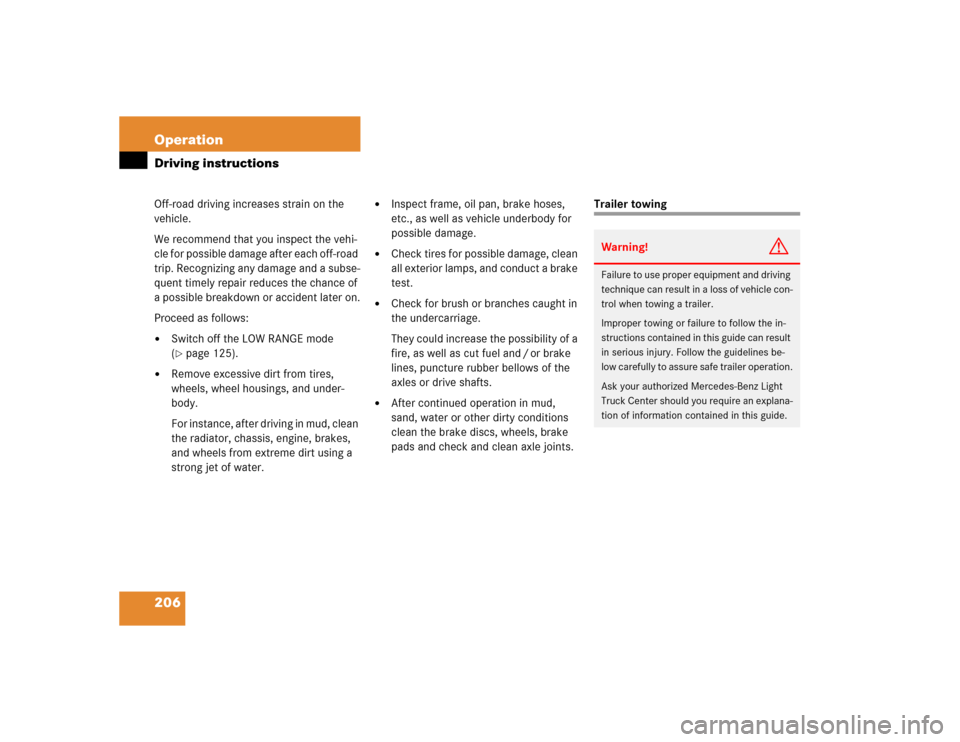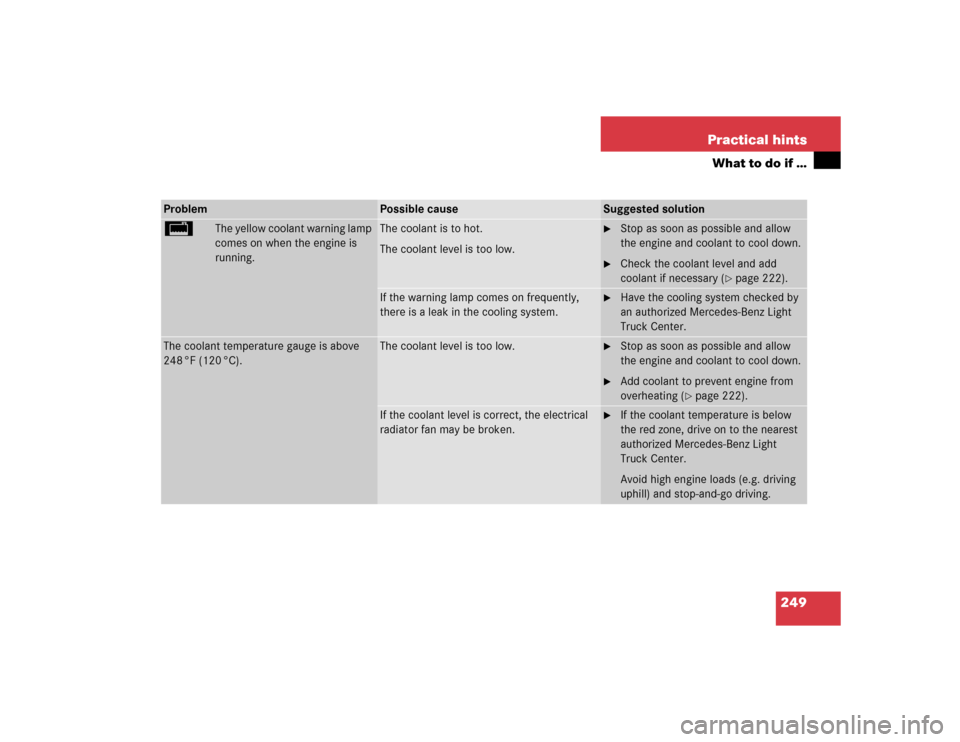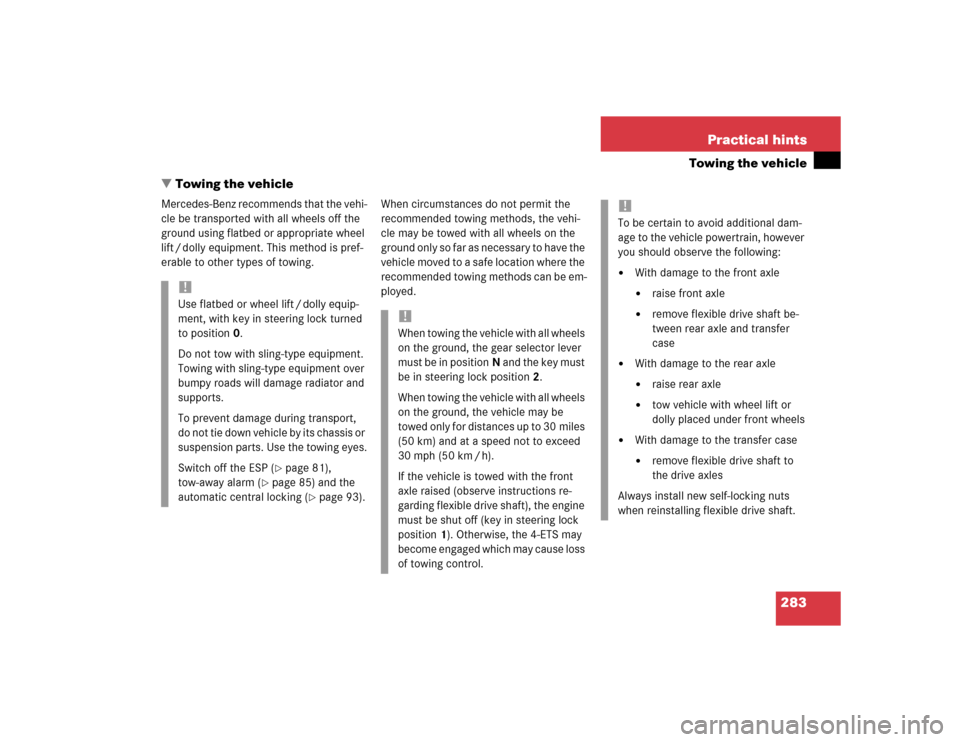Page 206 of 344

206 OperationDriving instructionsOff-road driving increases strain on the
vehicle.
We recommend that you inspect the vehi-
cle for possible damage after each off-road
trip. Recognizing any damage and a subse-
quent timely repair reduces the chance of
a possible breakdown or accident later on.
Proceed as follows:�
Switch off the LOW RANGE mode
(�page 125).
�
Remove excessive dirt from tires,
wheels, wheel housings, and under-
body.
For instance, after driving in mud, clean
the radiator, chassis, engine, brakes,
and wheels from extreme dirt using a
strong jet of water.
�
Inspect frame, oil pan, brake hoses,
etc., as well as vehicle underbody for
possible damage.
�
Check tires for possible damage, clean
all exterior lamps, and conduct a brake
test.
�
Check for brush or branches caught in
the undercarriage.
They could increase the possibility of a
fire, as well as cut fuel and / or brake
lines, puncture rubber bellows of the
axles or drive shafts.
�
After continued operation in mud,
sand, water or other dirty conditions
clean the brake discs, wheels, brake
pads and check and clean axle joints.
Trailer towingWarning!
G
Failure to use proper equipment and driving
technique can result in a loss of vehicle con-
trol when towing a trailer.
Improper towing or failure to follow the in-
structions contained in this guide can result
in serious injury. Follow the guidelines be-
low carefully to assure safe trailer operation.
Ask your authorized Mercedes-Benz Light
Truck Center should you require an explana-
tion of information contained in this guide.
Page 217 of 344

217 Operation
Engine compartment
�Engine compartment
Hood
Opening
1Release lever
�
Pull release lever1 downwards.
The hood is unlocked. Handle2 pro-
trudes slightly from the radiator-grille.
If not, lift the hood slightly.
2Handle for opening the hood
�
Pull handle2 to its stop out of the
radiator-grille.
�
Pull up on the hood and then release it.
The hood will be automatically held
open at shoulder height by gas-filled
struts.
Warning!
G
Do not pull the release lever while the vehi-
cle is in motion. Otherwise the hood could
be forced open by passing air flow.
!To avoid damage to the windshield wip-
ers or hood, never open the hood if the
wiper arms are folded forward away
from the windshield.
Warning!
G
To help prevent personal injury, stay clear of
moving parts when the hood is open and the
engine is running. Make sure the hood is
properly closed before driving. When closing
the hood, use extreme caution not to catch
hands or fingers.
The radiator fan may continue to run for ap-
proximately 30 seconds or even restart af-
ter the engine has been turned off. Stay
clear of fan blades.
��
Page 249 of 344

249 Practical hints
What to do if …
Problem
Possible cause
Suggested solution
/
The yellow coolant warning lamp
comes on when the engine is
running.
The coolant is to hot.
The coolant level is too low.
�
Stop as soon as possible and allow
the engine and coolant to cool down.
�
Check the coolant level and add
coolant if necessary (
�page 222).
If the warning lamp comes on frequently,
there is a leak in the cooling system.
�
Have the cooling system checked by
an authorized Mercedes-Benz Light
Truck Center.
The coolant temperature gauge is above
248 °F (120 °C).
The coolant level is too low.
�
Stop as soon as possible and allow
the engine and coolant to cool down.
�
Add coolant to prevent engine from
overheating (
�page 222).
If the coolant level is correct, the electrical
radiator fan may be broken.
�
If the coolant temperature is below
the red zone, drive on to the nearest
authorized Mercedes-Benz Light
Truck Center.
Avoid high engine loads (e.g. driving
uphill) and stop-and-go driving.
Page 283 of 344

283 Practical hints
Towing the vehicle
�Towing the vehicle
Mercedes-Benz recommends that the vehi-
cle be transported with all wheels off the
ground using flatbed or appropriate wheel
lift / dolly equipment. This method is pref-
erable to other types of towing.When circumstances do not permit the
recommended towing methods, the vehi-
cle may be towed with all wheels on the
ground only so far as necessary to have the
vehicle moved to a safe location where the
recommended towing methods can be em-
ployed.
!Use flatbed or wheel lift / dolly equip-
ment, with key in steering lock turned
to position0.
Do not tow with sling-type equipment.
Towing with sling-type equipment over
bumpy roads will damage radiator and
supports.
To prevent damage during transport,
do not tie down vehicle by its chassis or
suspension parts. Use the towing eyes.
Switch off the ESP (
�page 81),
tow-away alarm (
�page 85) and the
automatic central locking (
�page 93).
!When towing the vehicle with all wheels
on the ground, the gear selector lever
must be in positionN and the key must
be in steering lock position2.
When towing the vehicle with all wheels
on the ground, the vehicle may be
towed only for distances up to 30 miles
(50 km) and at a speed not to exceed
30 mph (50 km / h).
If the vehicle is towed with the front
axle raised (observe instructions re-
garding flexible drive shaft), the engine
must be shut off (key in steering lock
position1). Otherwise, the 4-ETS may
become engaged which may cause loss
of towing control.
!To be certain to avoid additional dam-
age to the vehicle powertrain, however
you should observe the following:�
With damage to the front axle�
raise front axle
�
remove flexible drive shaft be-
tween rear axle and transfer
case
�
With damage to the rear axle�
raise rear axle
�
tow vehicle with wheel lift or
dolly placed under front wheels
�
With damage to the transfer case�
remove flexible drive shaft to
the drive axles
Always install new self-locking nuts
when reinstalling flexible drive shaft.